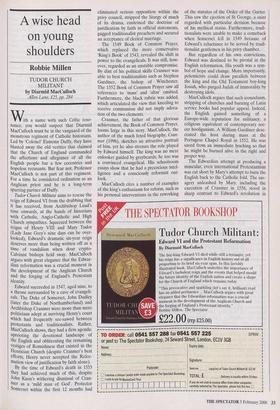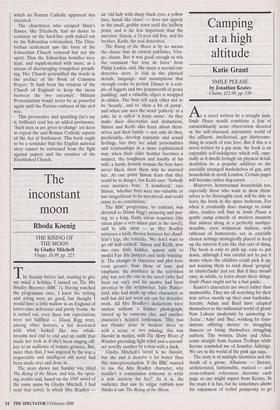A wise head on young shoulders
Robbie Millen
TUDOR CHURCH MILITANT by Diarmid MacCulloch Allen Lane, £25, pp. 284 With a name with such Celtic reso- nance, you would suspect that Diarmid MacCulloch must be in the vanguard of the monstrous regiment of Catholic historians. Led by 'Colonel' Eamonn Duffy, they have blasted away the old verities that claimed that the Church of England commanded the affections and allegiance of all the English people bar a few eccentrics and hopeless recusants. But fear not, Professor MacCulloch is not part of this regiment. For a time he considered ordination as an Anglican priest and he is a long-term sparring partner of Duffy.
Tudor Church Militant aims to rescue the reign of Edward VI from the drubbing that it has received, from Archbishop Laud's time onwards, at the hands of historians With Catholic, Anglo-Catholic and High Church sympathies. Squeezed between the reigns of Henry VIII and Mary Tudor (Lady Jane Grey's nine days can be over- looked), Edward's dramatic six-year reign deserves more than being written off as a time of vandalism when dour crypto- Calvinist bishops held sway. MacCulloch argues with great elegance that the Edwar- dian reformation was a crucial moment in the development of the Anglican Church and the forging of England's Protestant identity.
Edward succeeded in 1547, aged nine, to a throne surrounded by a cave of evangeli- cals. The Duke of Somerset, John Dudley (later the Duke of Northumberland) and Archbishop Cranmer were more than mere Politicians adept at surviving Henry's court Which had frequently see-sawed between protestants and traditionalists. Rather, MacCulloch shows, they had a firm agenda: Uprooting the devotional landscape of the English and obliterating the remaining vestiges of Romishness that existed in the Henrician Church (despite Cranmer's best efforts, Henry never accepted the Refor- mation view of justification by faith alone). By the time of Edward's death in 1553 they had achieved much of this, despite John Knox's withering dismissal of Cran- mer as a 'mild man of God'. Protector Somerset within the first 12 months had eliminated serious opposition within the privy council, stripped the liturgy of much of its drama, enshrined the doctrine of justification by faith in official statements, gagged traditionalist preachers and secured an acceptance of clerical marriage.
The 1549 Book of Common Prayer, which replaced the more conservative 'King's Book' of 1543, revealed the shift in power to the evangelicals. It was still, how- ever, regarded as an unstable compromise. By dint of his political skills Cranmer was able to best traditionalists such as Stephen Gardiner, the bishop of Winchester. The 1552 Book of Common Prayer saw all references to 'mass' and 'altar' omitted. Furthermore, the black rubric was added, which articulated the view that kneeling to receive communion did not imply adora- tion of the two elements.
Cranmer, the father of that glorious achievement, the Book of Common Prayer, looms large in this story. MacCulloch, the author of the much feted biography, Cran- mer (1996), sketches an attractive portrait of him, yet he also stresses the role played by Edward himself. The king was no mere onlooker guided by greybeards; he too was a convinced evangelical. His schoolroom essays show that he had a precocious intel- ligence and a consciously reformist out- look.
MacCulloch cites a number of examples of the king's enthusiasm for reform, such as his personal interventions in the reworking of the statutes of the Order of the Garter. This saw the ejection of St George, a saint regarded with particular derision because of his mythical status. Furthermore, tradi- tionalists were unable to make a comeback when Somerset fell in 1549 because of Edward's reluctance to be served by tradi- tionalist gentlemen in his privy chamber.
But regardless of his own convictions, Edward was destined to be pivotal in the English reformation. His youth was a sym- bol of hope and change. More importantly, polemicists could draw parallels between the king and the Old Testament boy-king Josiah, who purged Judah of immorality by destroying idols.
MacCulloch argues that such iconoclasm, stripping of churches and burning of Latin service books had popular appeal. Indeed, the English gained something of a Europe-wide reputation for militancy; a religious equivalent of contemporary soc- cer hooliganism. A William Gardiner dese- crated the host during mass at the Portugese Chapel Royal in 1552. He was saved from an immediate lynching so that he might be burned alive in the right and proper way.
The Edwardian attempt at producing a muscular, even international Protestantism was cut short by Mary's attempt to burn the English back to the Catholic fold. The sav- agery unleashed by Mary, including the execution of Cranmer in 1556, stood in sharp contrast to Edward's revolution in which no Roman Catholic opponent was executed.
The churchmen who escaped Mary's flames, like Elizabeth, had no desire to continue on the hard-line path staked out by the Edwardian reformation. The Eliza- bethan settlement saw the form of the Edwardian Church restored but not the spirit. Thus the Edwardian homilies were kept, and supplemented with more, as a means of discouraging evangelical preach- ing. Her Church personified the words in the preface of the Book of Common Prayer, 'It hath been the wisdom of the Church of England to keep the mean between the two extremes'. Militant Protestantism would never be as powerful again until the Puritan outburst of the civil war.
This provocative and sparkling (let's say it, brilliant) read has an added pertinence. 'Such men as are given to change' are keen to repeal the anti-Roman Catholic aspects of the Act of Settlement. This book ought to be a reminder that the English national story cannot be extricated from the fight against popery and the creation of the Established Church.



























































 Previous page
Previous page